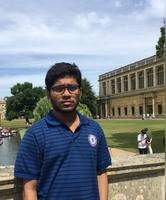The LIGO (Laser Interferometer Gravitational-Wave Observatory) Experiment – A completely different perspective of studying the universe.
Einstein’s Prediction

Over a century ago, Albert Einstein proposed the idea of something called a Gravitational Wave which was a part of his General Theory of Relativity. The concept of Gravitational waves suggests that, the force of gravity is not an actual force but rather, a distortion in the fabric of spacetime. This was just an idea, as there was no experimental evidence to support Einstein’s claim.
What is a gravitational wave?
A gravitational wave is much like an ordinary ripple caused by any distortion in a medium. The only difference here is that the ripple is in the medium(fabric) of spacetime. A gravitational wave originates from an accelerating mass in spacetime. Some phenomena that could trigger a gravitational wave are two black holes rotating in a dead spiral, collision of neutron stars, or even a ball dropping off your hand. The gravitational waves compress space in one direction and expand it in the orthogonal direction.
Conceiving the idea for an experimental setup for detecting gravitational waves
During the early 1970s an ambitious professor at the MIT named Rainer Weiss first proposed the idea of an experimental setup to detect gravitational waves. His idea was funded by the US national science foundation, and the very first version of the LIGO was setup in 1983. This very primitive version of the LIGO which had arms of length 1km failed to produce any concrete evidence of gravitational waves. It was not until 2014 that the advanced LIGO was made fully operational. Rainer Weiss recently won the Nobel prize for Physics in 2017.

When were the first gravitational waves detected?
On the 14th of September, Rainer Weiss noticed something peculiar on the usual activity log of the LIGO. He instantly contacted the field engineers who were present at the observatory and Weiss was completely dumbfounded. Gravitational waves from the merger of two black holes, each of nearly 30 solar masses, 1.5 billion light years away were detected for a fraction of a second.
So, how does the LIGO exactly detect these “Gravitational waves”?
The LIGO basically comprises of two 4km arms placed perpendicular to each other. The current LIGO setups are in two remote locations in the United States, one in the Washington state and the other three thousand kilometres away in Louisiana. A very coherent light from an extremely sensitive laser is produced which passes through a beam splitter, which splits the light into two perpendicular components. These two perpendicular components pass through the 4km arms of the LIGO which are highly depressurised (almost vacuum). We know that the ultimate law of physics states that the speed of light is unaltered irrespective of the expansion or compression of the space. The LIGO makes use of this ultimate law to detect and classify gravitational waves. Now, when the light is reflected from the mirrors placed at the extreme ends of the arms comes back to the beam splitter and then falls onto a sensor, there are two possible scenarios:
-
The two light beams being 180 degrees out of phase will cancel out each other and nothing will be detected by the sensor – this will happen when the two light beams traverse the exact same path.
-
The two light beams have a phase difference other than 180 degrees. In this case the two beams will not exactly cancel out each other hence leaving a difference in the amplitudes. This small difference in the amplitudes is detected by the sensor, giving information about the gravitational wave that struck the LIGO apparatus.

The principle doesn’t look that complicated, then why did it take so many years to get it operational?
The most important aspect of this observatory is the sensitivity of the measuring instruments that are used in the setup. The gravitational waves come from hundreds of millions of light years away and hence their intensity is very weak. The LIGO measures lengths of the order 10-21 of a meter. This length is roughly the size of one thousandths of the diameter of a typical atomic nucleus. To get such sensitive measurements the LIGO uses the purest of laser light and mirrors of the highest quality. The mirrors weigh about ninety kilos each and are highly polished. The reason that the LIGO is placed in such isolated locations is to prevent any stray noise from interfering with the data. The LIGO also uses technology such as internal seismic isolation to prevent any stray noise from corrupting the results obtained. The two LIGO setups are placed so far off from each other so that the common portion of the response of the sensors can be filtered out thus eliminating the chance of any common noise. This makes the LIGO truly an engineering marvel.

What role did India play in the LIGO experiment?
The IUCAA (Inter University Centre for Astronomy and Astrophysics) at Pune played an important role in the research and development of the experiment. About 40 scientists from India participated in the experiment. India has taken a further step ahead and has decided on building a LIGO apparatus at a project cost of 1000 Cr.
How does the gravitational wave picture change our understanding of the cosmos?
Primarily, it confirms the predictions of Einstein’s General Theory of Relativity that the universe is a fabric of spacetime and gravity is nothing but a distortion in space time. It also opens a whole new gateway to studying the universe. Gravitational waves can help us to understand the universe beyond the apparent. It could help us understand phenomena that isn’t apparent through a telescope, like what happens at the core of two stars during their collision.
